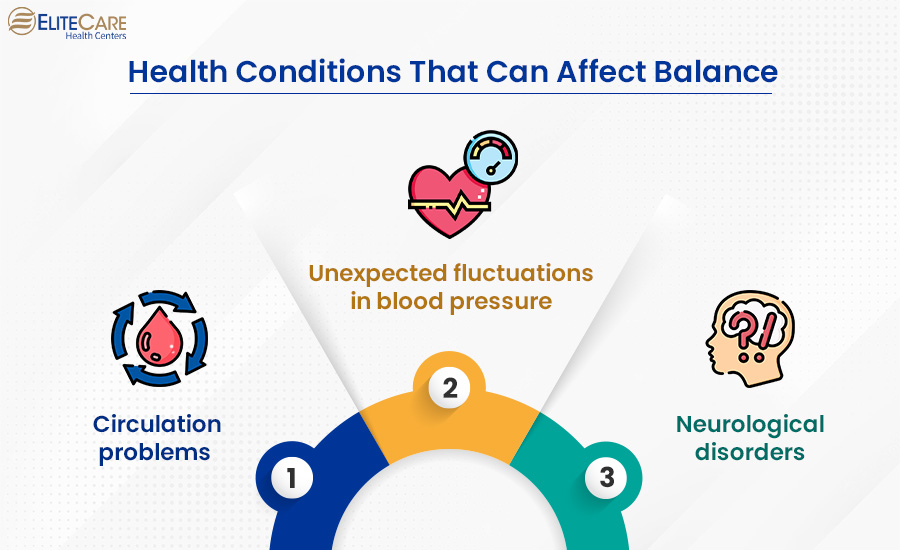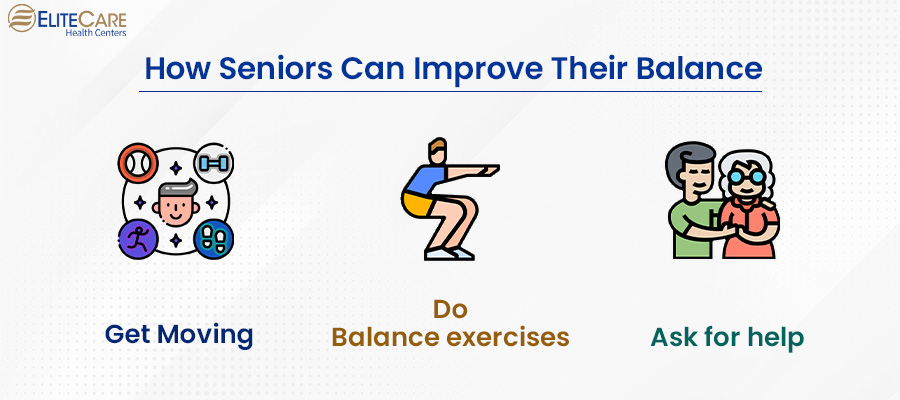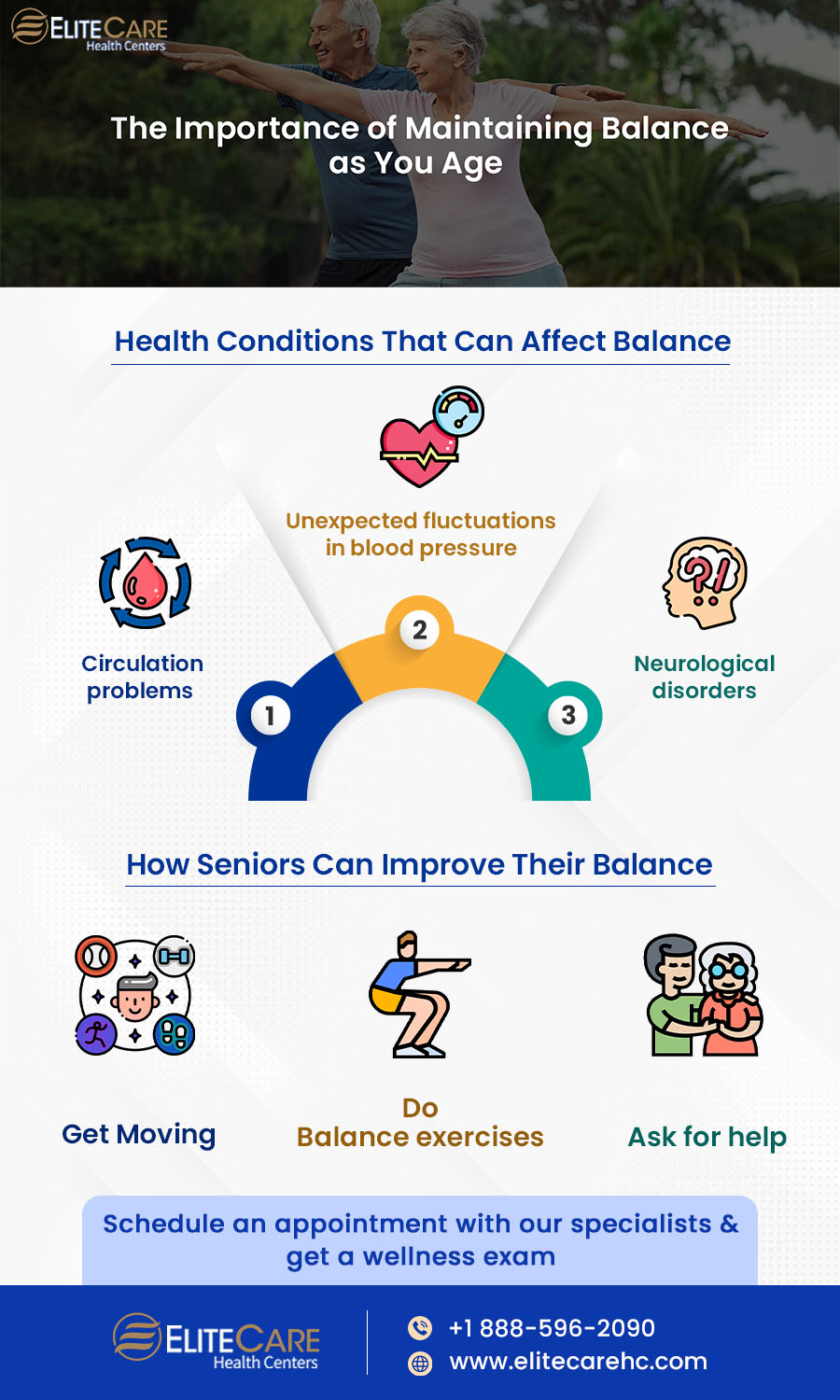
We rarely think about balance when we are young. It is something that we take for granted as we effortlessly move our bodies around. But as we age, the quality of balance and hence the ability to walk and move freely can become a challenge. Seniors with balance issues are more likely to have falls and get injured or even break a bone.
Unsteady gait is a serious concern among elderly people, because fractures and other bone injuries resulting from falls often heal very slowly. Sometimes the person may not make a complete recovery.
Why Does the Quality of Balance Get Affected With Age?

Old age is often associated with a higher risk of health problems. Loss of balance is frequently a sign of another health problem rather than a separate condition.
As people age, the way they walk changes. This is because the muscle, joint, and bone deterioration impact posture and gait, resulting in reduced and impaired quality of movement. Poor gait (walking pattern) may result in poor balance and lead to various other issues. When seniors experience imbalance, they may feel faint, sick, or shaky and can lead to injury.
The following health conditions can cause balance issues:
- Unexpected fluctuations in blood pressure: The body grows less efficient at pumping blood through the veins with each passing year. Blood pressure drops when one stands up from a sitting position too quickly or while making a sudden movement. If this occurs, the person may feel dizzy, nauseous, or nauseated or lose their balance for a moment before swiftly regaining it. As blood pressure returns to normal, the symptoms should fade.
- Circulation problems: When the body is not as efficient at pumping blood as it once was, the overall blood circulation in the body suffers. The brain, muscles, and organs do not receive oxygen supply adequately or efficiently. This may occasionally lead to loss of balance.
- Neurological disorders Seniors with health conditions such as Parkinson’s disease or multiple sclerosis may also suffer from balance issues.
Apart from these, body strength plays a key role in maintaining our balance, and weakness in the body can also lead to poor quality of balance. Also, there are some health conditions, such as Benign Paroxysmal Positional Vertigo (BPPV), Labyrinthitis (an inner ear infection), Meniere’s Disease (fluid buildup in the ear’s inner chamber), which can also lead to balance problems.
Role of Strength in Balance
One of the most common causes of poor balance in the elderly is a lack of leg and back strength and mobility. Weak legs combined with excess weight are especially dangerous because they raise the person’s center of gravity.
Strength training is the solution for improving balance in seniors since it helps improve muscle tone, which further improves balance and provides more cushion for their bones in case of a fall.
Proper strength training is necessary to improve balance to its full potential. Routine strength training will allow the limbs to have a full range of motion and gain strength in the long run.
How to Test Balancing Capability in Seniors
Seniors can perform a basic balance test to determine their level of balance. The test must be done in the presence of another person such as a caregiver or family member.
The test recommended here is by a physical therapist and may be tried at home. Ask the senior to stand on one foot and lift the other leg six inches off the floor. Count to 30 while keeping your feet off the floor. If they begin to wobble before the count of thirty, they may have a balance problem. Consult a physician and discuss the issue to avoid further complications.
There is also a CDC-recommended 4-stage balance test for seniors who want to be thorough with their evaluation.
How Seniors Can Improve Their Balance

For seniors to maintain their balance, they need to incorporate healthy exercise that boosts their balance. Recent research findings have shown that exercise can reduce the fall rate by 23% in older adults, and reduce the risk of fall-related injuries, including fractures, head injuries etc., which may lead to hospitalization.
Along with exercise, here are a few tips that can help improve the balancing capability in seniors.
1. Get moving
Seniors with a sedentary lifestyle are prone to diseases like sarcopenia (reduced muscle mass), weaker bones, and limited walking routines. The reduction in movement is a serious concern among seniors and can lead to poor mobility with many other potential problems.
Make things as simple and enjoyable as possible for seniors. A walk in nature, swimming, or attempting new activities – Tai Chi, bowling, aqua aerobics, golf, yoga, and tennis are all fantastic ideas if they enjoy them.
Read More: The Importance of Healthcare and Wellness
2. Do balance exercises
Medical professionals have emphasized that three balance exercises, tandem standing, braiding, and rock steps can significantly improve balance in people across different age groups. Seniors can also practice easy balance exercises like tree pose, single leg balance, and weight shift in their daily lives to regain balance and stability.
Keep technique in mind when performing exercises; this is the golden rule when beginning any exercise routine. There is more importance to the quality of a workout than the number and speed of exercises performed.
With that in mind, if these exercises feel inappropriate, cause pain, or cause weariness, discontinue them. Make sure that these exercises are performed correctly, and well with the senior’s capabilities under supervision and guidance. Contact a primary care physician and discuss the exercise routine thoroughly to prevent any injury.
3. Ask for help
Seniors new to an exercise regime or having trouble with mobility should consider having an exercise partner. Including someone who helps with constructive feedback and general safety is important.
How Often Should You Exercise to Improve Balance?
Seniors can do balance exercises on a daily basis or as frequently as they prefer. However, older adults should include balance training at least three days a week in their exercise regime. It is also recommended to follow a set of standardized exercises from a program that has effectively reduced the risk of falls.
Summing up
Seniors are at a higher risk of falling, which makes balance issues a critical worry. Stay consistent with the balance exercises and reduce the risk of falling. Even for seniors who are not particularly concerned about falling, they must keep in mind that balance exercises and fitness can help them feel better overall. The bones and muscles will be stronger, and the cardiovascular system will benefit from it as well.
For any further queries or concerns about improving balance in seniors, contact EliteCare Health Centers. We are a leading medical clinic in Florida offering a wide range of senior care services including annual physical exams, routine screenings, vaccinations, etc. Visit our website to request an appointment with our board-certified primary care physicians at your nearest healthcare center.
- Tags:balance exercisesbalance tips for seniorshealth and wellness centerhealth and wellness serviceshealth care centerknee pain treatmentmedical cliniconline doctor consultationpreventive careprimary careprimary care physicianprimary care servicesprimary servicessenior care serviceswellness care centerswellness center






